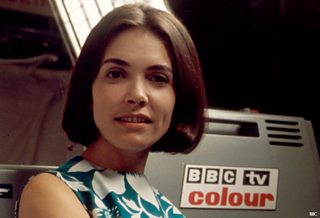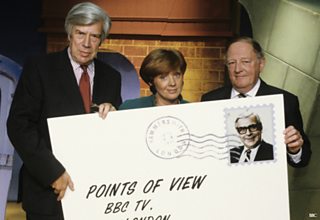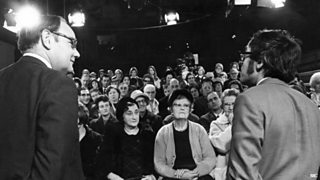
Joan Bakewell of Late Night Line-Up prepares to review the evening's output
Current series , shown at 6.30pm on ��������2, is one of the long line of shows that looks forward to other forthcoming programmes in a rather more lavish way than the standard 30 second preview.
There is also a slightly less long tradition of programmes looking back at recent output, and often offering viewers the chance to have their say.
Obviously Radio Times has always been available, at least since 1923, as a way of finding out what programmes were on the ��������, but television preview programmes have the advantage of being able to feature live interviews with the people involved, and even to present clips from upcoming fare.
The earliest preview programme was called, fittingly, Pre-View, and was transmitted in the early television service in 1937-8. This was an inventive show which didn’t just talk about the following week’s output, but despite the service being mostly live, illustrated programmes to come by staging mock rehearsals, showing the technical preparations, and in one memorable having a dream sequence in which announcer/presenter Elizabeth Cowell was shown things to come via a gadget invented by a ‘mad scientist’.
Similar programmes were also shown in the 1950s, as the TV publicity machine rolled into action. The Coronation in 1953 was preceded by a series of in-depth . With the advent of ��������2 in 1964, it was decided to go to town on the presentation aspect of the channel, with in-vision announcements linking the programmes more elaborately than those which were in the process of being phased out on ��������1.
Each evening started with a short programme, presented by the team of announcers, called , in which the evening’s programmes were trailed (though of course the first edition was postponed from 20 April 1964 to the next night due to the power cut that blacked out the opening of the new channel).
After some months this was revamped into a review programme discussing what had just gone out, and not just on ��������2. It gradually turned into a more general discussion slot only slightly related to specific programmes. As it was now broadcast last thing at night in an open-ended slot which could last half an hour, it was re-christened . Line-Up, as it was often still referred to, launched many television careers, including first-night anchor man Denis Tuohy, Michael Dean, Joan Bakewell, Tony Bilbow and Sheridan Morley.
It also spun off into the realms of archive clip-shows with , Film Night, Colour Me Pop and covering a range of topics. The final edition went out in 1972 but its influence lingered on, and it was reborn as in 1989.

It's not essential to be called Robinson if you want to present Points of View, but it doesn't do any harm...
Other television review programmes were to follow, but the longest running of them all had already debuted in 1961, in the form of . First presented by Robert Robinson, later presenters included Kenneth Robinson, Anne Robinson and Tony Robinson… spot the theme! Robert Robinson pioneered the almost sneering, cynical tone, even though the show was superficially light-hearted. However it was a great success, as a five-minute filler that allowed viewers to vent their spleen, moderated by Robinson who seemed equally unimpressed by most of the programmes in question.
The show also delighted in quirky, whimsical items, which allowed trainee directors to indulge themselves with little films, such as a day in the life of the Points of View office, and a classic sequence where a scene from Z Cars was dubbed with the voices of Bill and Ben, the Flowerpot Men.
From 1963, Robert Robinson also presented , which ran until 1970. It too had its comedy films, and had occasional interviews with stars, such as Doctor Who’s William Hartnell in a 1965 edition.
When the series ended it was replaced by , in which criticism was less of an element, and children instead asked to see clips of recent programmes. A star guest would be interviewed by host Michael Aspel, with some questions sent in by viewers. Children’s criticisms were still aired in series such as Search, What Do You Watch and Take Two. Ask Aspel ran until 1981, with the last guest being Paul Nicholas.

Cliff Michelmore and guest Anthony Smith survey the friendly audience of Talkback in 1968
Adult viewers and their concerns were not forgotten, and growing criticism of television from the likes of the National Viewers and Listeners Association led to the series in 1967, in which viewers could directly interrogate television professionals about subjects raised by programmes, such as the perennial sex and violence, and controversial programmes like A Question of Ulster. Original host David Coleman was succeeded by Cliff Michelmore and then Michael Barrett before the series ended in 1972.
While the interrogating viewers ranged from the motivated and haranguing (such as Mary Whitehouse herself) to the barely coherent, it was hard for ordinary members of the public to out-argue seasoned media performers. However a carefully selected studio audience, who gave instant reactions with an electronic voting system, gave a more balanced view – and it was interesting how moderate this often was.
In 1980 was launched, which looked at selected television programmes – three a week, with three guests discussing them, chosen for their particular interest or expertise in the subject area of one of them. The regular host was Ludovic Kennedy. The series also featured an authored piece at the end, almost like a mini-MacTaggart lecture. Among these was journalist Gavin Scott’s 1982 discourse on the of Doctor Who, in the wake of the Cybermen returning to the series the same week after seven years’ absence.
Since this series’ demise, serious discussion of programmes, without the intervention of a studio audience, has mainly been confined to items on shows such as , where they can come a poor second to what are still considered superior media, including films, books and theatre.
The live phone-in series , which ran as part of the expansion of daytime television from 1986, was able to offer instant reaction to programmes from the night before, with phone-ins, which sometimes left producers, writers and actors who were subjected to vitriolic reactions from viewers, at a loss for words.
In the current age of instant internet reaction, on-screen television reviewing has become a rare thing. Points of View soldiers on – it was dropped for most of the 70s before being revived with Barry Took as its host, then a succession of replacements before Terry Wogan and then Jeremy Vine assumed the role.
Reviewing and previewing are of course different animals. The latter is essentially publicity, and it would be a brave channel controller who commissioned a show that had harsh things to say about his or her output in advance – unlike the criticism that can be levelled at other media. Too Much TV is of course, as the title implies, a reaction to the modern TV landscape where hundreds of channels compete, even if it seems only a few more than the old handful have anything other than repeats, cheap imports, or shopping programmes…
Is there a future for the television review – or is the age of chewing gum for the eyes no further away than it ever was? Has the internet rendered these programmes obsolete? Let us know your thoughts in the space below.
